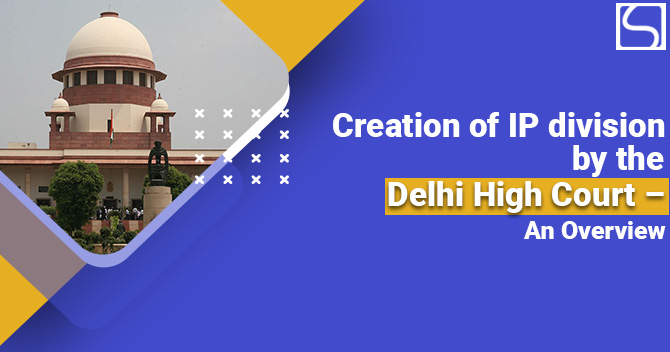Creation of IP division by the Delhi High Court – An Overview

Karan Singh | Updated: Oct 16, 2021 | Category: Intellectual Property
Currently, in India, due to the growing R&D, various IPs came up and with a boost in invention came disputes regarding Intellectual Properties. With the elimination of various Boards & Appellate Tribunals by Tribunals Reforms (Rationalization & Condition of Service) Ordinance 2021, which was issued by the Indian President and was informed on 4th April 2021. To deal with the IP matters, the creation of IP division by the Delhi High Court has been taken place. Among the 25 High Courts of India, the High Court of Delhi has always been a leading venue in deciding Intellectual Property[1] cases.
Table of Contents
What is the Primary Reason Behind the Creation of IP Division by the Delhi High Court?
Using Tribunals Reforms (Rationalization & Condition of Service) Ordinance 2021, the Indian Government scrapped the appellate board to mention inefficiency. The reason behind the creation of the appellate board was quicker delivery of justice & reduction of dependence on High Courts, but the appellate board failed as there were various cases pending in the appellate board & it was facing problems regarding the shortage of staff. Following this ordinance, all the pending or in progress cases of the IPAB were subsequently transferred to the High Courts. Because of this, the High Court of Delhi suggesting the creation of IP division.
Objectives behind the Creation of IP division by Delhi High Court
Following are the objectives behind the creation of IP division by the Delhi High Court:
- New IPR filing;
- Cancellation and revocation of applications;
- Appeals from the Trademark Registrar, Copyright Registrar, Controller of Patents;
- Appellate Proceedings & Original Proceedings;
- Writ petitions;
- FAO (First Appeal from Order);
- RFA (Regular First Appeals);
- Intellectual Property (IP) Disputes;
- All other proceedings that were defendable before the erstwhile IPAB (Intellectual Property Appellate Board) under the Copyrights, Patents, Trademarks, and Designs Act.
The primary aim behind the creation of IP division by the Delhi High Court for expedite clearance of disputes concerning IPR. The High Court of Delhi has been formulating rules & regulations for the newly created body IPAB.
How does the Creation of IP Division Impact the IP Cases in India?
- High Courts in India naturally carry higher worth than any other tribunal, so converting the IPAB to an extension inside the High Court of Delhi would significantly increase the significance of IP in India. The decisions given by the extension wing of a High Court shall clearly have an advantage, and higher significance as precedents in future and due to the technical expertise of judges’ dependability on those decisions would increase exponentially.
- The IPAB’s problems were the lack of staff and non-appointment of the chairperson, which would hardly to a problem in any High Court;
- This new IP dispute settlement would outcome in a more consistent and efficient Intellectual Property redressal & other High Courts would finally follow the same method. This is because most cases of the IPAB was appealed to the High Court of Delhi, so they carry the required experience to deal with the IP disputes, and with the adoption of similar mechanisms by other High Courts, specialised bodies will sprout within the courts that will have proficiency in IP problems as they would even make something identical to Delhi High Court rules governing Patent Cases, 2020 which would advise them as it would do in the case of Delhi HC.
- There might be candidates or Patent owners who would have to wait for more, in other terms, waste their exploitation right (in case of Patents on the majority basis – time is less than twenty years with two or three years wasted already on achieving registration) being decreased as they have to wait & lose more years for the IP division to work on their fullest extent;
- Since the IP division is an extension of the High Court, there would be higher litigation expenditure by the candidates;
- There will be an intended approach made by the judges who have technical expertise (as it is needed in case of dealing Patent cases) and have faced IP problems earlier. This shall result in consistent, streamlined, and predictable decisions. This new system would abolish such confusion and would give several exposures to IP disputes.
Different Measures Taken BY IPAB
- The judges’ tenure should be extended and kept for longer periods so that they could create the required technical proficiency in any IP subject matter;
- Because of the huge obeyance of cases, there are possibilities that candidates might have totally lost interest in their subject matters. So fixed time durations should be made for completing the promises made before the court. This should be done specially for cases that have been pending in the IPAB for more than one year. There must be a discouragement for any postponement should be considered;
- Increase the number of judges in the IP division for swift justice.
Conclusion
After discussing the reason and impact of the creation of IP division by the Delhi High Court, it is concluded that constant delays were a big reason for scrapping the IPAB, but now, when it is added to the High Court, it may lead to more long delays which may defeat the objective of this current High Court order. IP owners would have to bear with issues as due to this, there might be a shortage of time for exploitation of their IP rights. There might be some extra costs for litigation in the High Courts also.
Read our article:IPR for Start-ups in Singapore – A Complete Analysis














